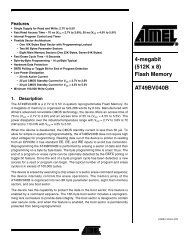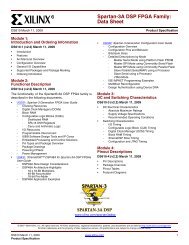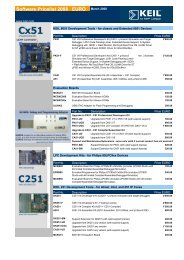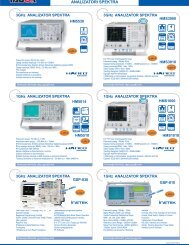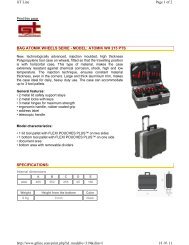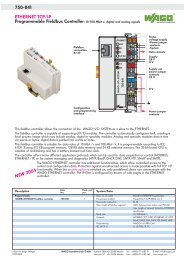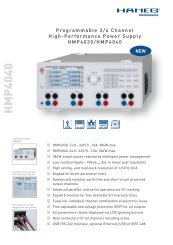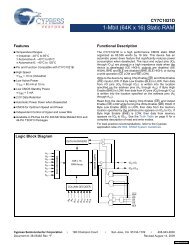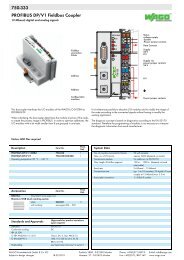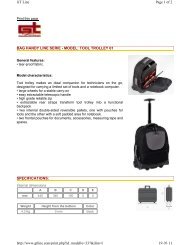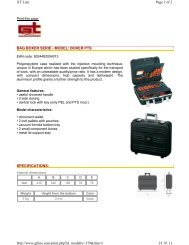PIC12F683 Data Sheet - Microchip
PIC12F683 Data Sheet - Microchip
PIC12F683 Data Sheet - Microchip
Create successful ePaper yourself
Turn your PDF publications into a flip-book with our unique Google optimized e-Paper software.
<strong>PIC12F683</strong><br />
13.0 INSTRUCTION SET SUMMARY<br />
The <strong>PIC12F683</strong> instruction set is highly orthogonal and<br />
is comprised of three basic categories:<br />
• Byte-oriented operations<br />
• Bit-oriented operations<br />
• Literal and control operations<br />
Each PIC16 instruction is a 14-bit word divided into an<br />
opcode, which specifies the instruction type and one or<br />
more operands, which further specify the operation of<br />
the instruction. The formats for each of the categories<br />
is presented in Figure 13-1, while the various opcode<br />
fields are summarized in Table 13-1.<br />
Table 13-2 lists the instructions recognized by the<br />
MPASM TM assembler.<br />
For byte-oriented instructions, ‘f’ represents a file<br />
register designator and ‘d’ represents a destination<br />
designator. The file register designator specifies which<br />
file register is to be used by the instruction.<br />
The destination designator specifies where the result of<br />
the operation is to be placed. If ‘d’ is zero, the result is<br />
placed in the W register. If ‘d’ is one, the result is placed<br />
in the file register specified in the instruction.<br />
For bit-oriented instructions, ‘b’ represents a bit field<br />
designator, which selects the bit affected by the<br />
operation, while ‘f’ represents the address of the file in<br />
which the bit is located.<br />
For literal and control operations, ‘k’ represents an<br />
8-bit or 11-bit constant, or literal value.<br />
One instruction cycle consists of four oscillator periods;<br />
for an oscillator frequency of 4 MHz, this gives a<br />
nominal instruction execution time of 1 μs. All<br />
instructions are executed within a single instruction<br />
cycle, unless a conditional test is true, or the program<br />
counter is changed as a result of an instruction. When<br />
this occurs, the execution takes two instruction cycles,<br />
with the second cycle executed as a NOP.<br />
All instruction examples use the format ‘0xhh’ to<br />
represent a hexadecimal number, where ‘h’ signifies a<br />
hexadecimal digit.<br />
13.1 Read-Modify-Write Operations<br />
Any instruction that specifies a file register as part of<br />
the instruction performs a Read-Modify-Write (R-M-W)<br />
operation. The register is read, the data is modified,<br />
and the result is stored according to either the instruction,<br />
or the destination designator ‘d’. A read operation<br />
is performed on a register even if the instruction writes<br />
to that register.<br />
For example, a CLRF PORTA instruction will read<br />
PORTA, clear all the data bits, then write the result back<br />
to PORTA. This example would have the unintended<br />
consequence of clearing the condition that set the RAIF<br />
flag.<br />
TABLE 13-1:<br />
Field<br />
FIGURE 13-1:<br />
OPCODE FIELD<br />
DESCRIPTIONS<br />
Description<br />
f Register file address (0x00 to 0x7F)<br />
W Working register (accumulator)<br />
b Bit address within an 8-bit file register<br />
k Literal field, constant data or label<br />
x Don’t care location (= 0 or 1).<br />
The assembler will generate code with x = 0.<br />
It is the recommended form of use for<br />
compatibility with all <strong>Microchip</strong> software tools.<br />
d Destination select; d = 0: store result in W,<br />
d = 1: store result in file register f.<br />
Default is d = 1.<br />
PC<br />
TO<br />
C<br />
DC<br />
Z<br />
PD<br />
Program Counter<br />
Time-out bit<br />
Carry bit<br />
Digit carry bit<br />
Zero bit<br />
Power-down bit<br />
GENERAL FORMAT FOR<br />
INSTRUCTIONS<br />
Byte-oriented file register operations<br />
13 8 7 6 0<br />
OPCODE d f (FILE #)<br />
d = 0 for destination W<br />
d = 1 for destination f<br />
f = 7-bit file register address<br />
Bit-oriented file register operations<br />
13 10 9 7 6 0<br />
OPCODE b (BIT #) f (FILE #)<br />
b = 3-bit bit address<br />
f = 7-bit file register address<br />
Literal and control operations<br />
General<br />
13 8 7 0<br />
OPCODE<br />
k (literal)<br />
k = 8-bit immediate value<br />
CALL and GOTO instructions only<br />
13 11 10 0<br />
OPCODE<br />
k (literal)<br />
k = 11-bit immediate value<br />
© 2007 <strong>Microchip</strong> Technology Inc. DS41211D-page 101



